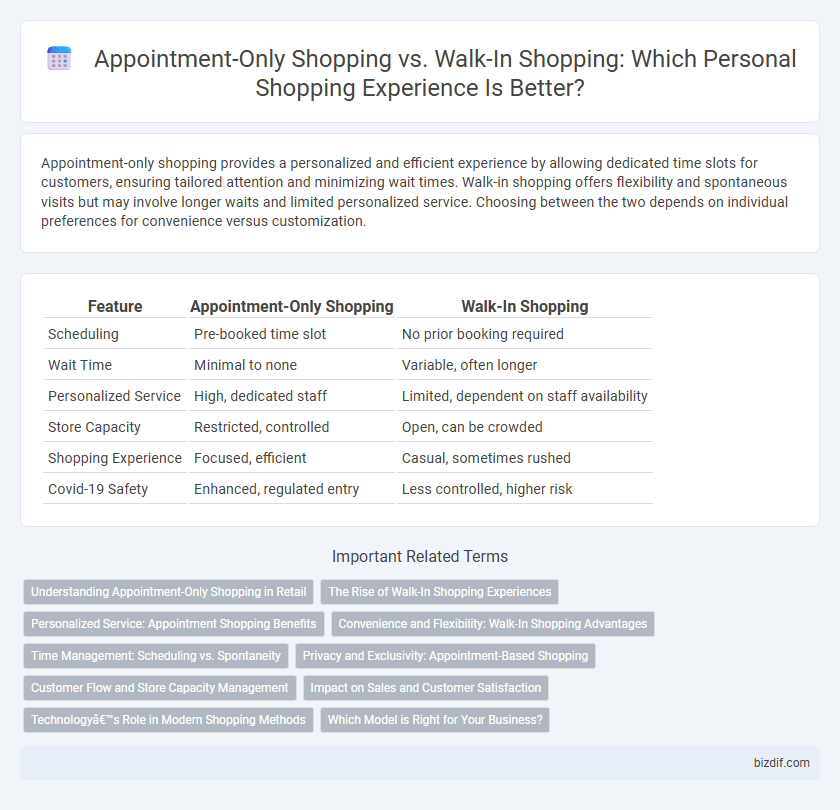Appointment-only shopping provides a personalized and efficient experience by allowing dedicated time slots for customers, ensuring tailored attention and minimizing wait times. Walk-in shopping offers flexibility and spontaneous visits but may involve longer waits and limited personalized service. Choosing between the two depends on individual preferences for convenience versus customization.
Table of Comparison
| Feature | Appointment-Only Shopping | Walk-In Shopping |
|---|---|---|
| Scheduling | Pre-booked time slot | No prior booking required |
| Wait Time | Minimal to none | Variable, often longer |
| Personalized Service | High, dedicated staff | Limited, dependent on staff availability |
| Store Capacity | Restricted, controlled | Open, can be crowded |
| Shopping Experience | Focused, efficient | Casual, sometimes rushed |
| Covid-19 Safety | Enhanced, regulated entry | Less controlled, higher risk |
Understanding Appointment-Only Shopping in Retail
Appointment-only shopping in retail offers a personalized experience where customers schedule dedicated time slots to receive tailored assistance from sales associates. This method ensures reduced wait times, exclusive access to products, and a more intimate shopping environment that enhances customer satisfaction. Retailers gain valuable insights into customer preferences, enabling them to provide customized service and improve inventory management.
The Rise of Walk-In Shopping Experiences
Walk-in shopping experiences have surged in popularity due to consumer demand for immediate access without scheduled appointments. Retailers are adapting by enhancing in-store availability and personalized services to accommodate spontaneous visits. This trend reflects a shift towards convenience and flexibility in personal shopping preferences.
Personalized Service: Appointment Shopping Benefits
Appointment-only shopping offers highly personalized service by allowing retailers to prepare for each customer's unique preferences and needs in advance. Shoppers receive dedicated attention from sales experts, ensuring product recommendations and styling advice tailored specifically to their tastes. This method minimizes wait times and creates a more exclusive, customized shopping experience compared to walk-in options.
Convenience and Flexibility: Walk-In Shopping Advantages
Walk-in shopping offers unmatched convenience by allowing customers to browse and purchase items without prior scheduling, accommodating spontaneous visits and last-minute needs. It provides flexibility in timing, enabling shoppers to explore stores at their own pace without being constrained by an appointment slot. Retailers benefit from increased foot traffic and impulse purchases, enhancing overall sales opportunities.
Time Management: Scheduling vs. Spontaneity
Appointment-only shopping allows customers to manage their time efficiently by securing a specific slot, reducing wait times and ensuring personalized service. Walk-in shopping offers spontaneity, catering to those who prefer flexibility but may face unpredictable wait periods and limited service availability. Balancing scheduled appointments with casual visits enhances overall time management for both shoppers and retailers.
Privacy and Exclusivity: Appointment-Based Shopping
Appointment-only shopping offers enhanced privacy by limiting access to the store, allowing clients to enjoy a discreet and personalized experience without interruptions. This exclusivity ensures dedicated attention from sales associates, tailored recommendations, and a calm environment free from crowds. Privacy-conscious shoppers benefit from secure, one-on-one consultations, making appointment-based shopping ideal for high-end purchases and sensitive transactions.
Customer Flow and Store Capacity Management
Appointment-only shopping allows retailers to manage customer flow precisely, reducing overcrowding and enhancing personalized service experiences. Stores can optimize their capacity by scheduling specific time slots, ensuring social distancing and inventory availability while minimizing wait times. In contrast, walk-in shopping often leads to unpredictable customer volumes, challenging effective space utilization and potentially diminishing overall service quality.
Impact on Sales and Customer Satisfaction
Appointment-only shopping boosts sales by providing personalized attention and reducing wait times, leading to higher customer satisfaction and repeat visits. Walk-in shopping offers convenience and spontaneity, attracting more foot traffic but may result in longer waits and less tailored service. Retailers balancing both methods can optimize overall sales performance while enhancing customer experience.
Technology’s Role in Modern Shopping Methods
Appointment-only shopping leverages advanced scheduling software and personalized data analytics to create a tailored and efficient shopping experience, reducing wait times and enhancing customer satisfaction. In contrast, walk-in shopping relies more on real-time inventory tracking and in-store digital displays to accommodate spontaneous visits and provide immediate product information. Both methods benefit from mobile apps and AI-driven recommendations, which streamline decision-making and optimize in-store navigation.
Which Model is Right for Your Business?
Appointment-only shopping enhances personalized customer experiences by allowing retailers to allocate dedicated time for each client, improving service quality and increasing conversion rates. Walk-in shopping offers greater accessibility and spontaneity, attracting a higher volume of traffic but often limiting individualized attention and potentially reducing customer satisfaction. Assessing your business model's goals, staffing capacity, and target market preferences will determine whether appointment-only or walk-in shopping aligns best with maximizing revenue and customer loyalty.
Appointment-Only Shopping vs Walk-In Shopping Infographic

 bizdif.com
bizdif.com